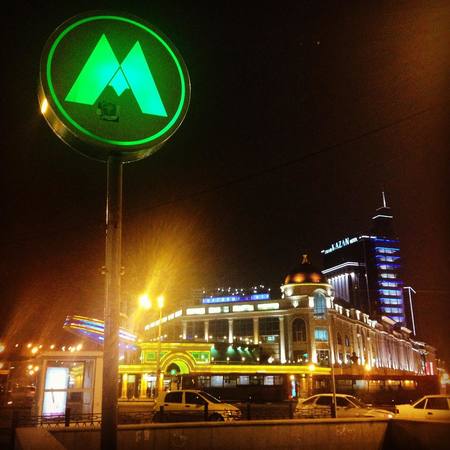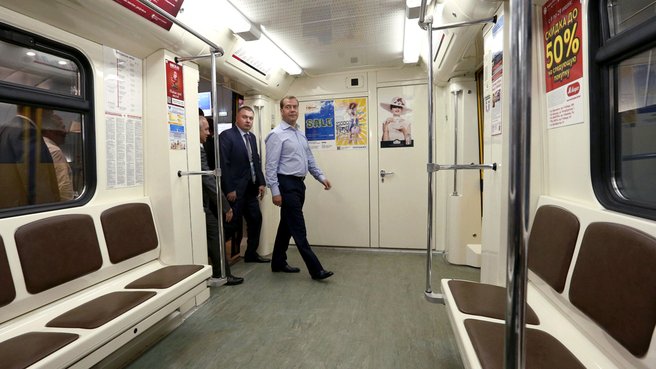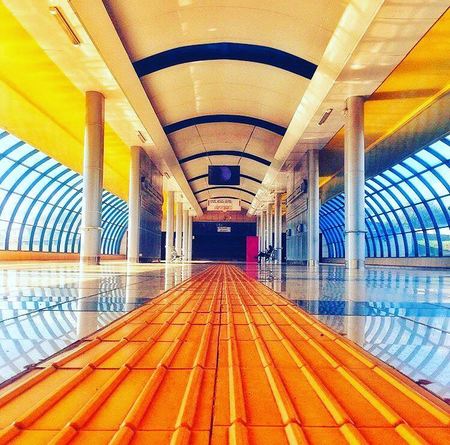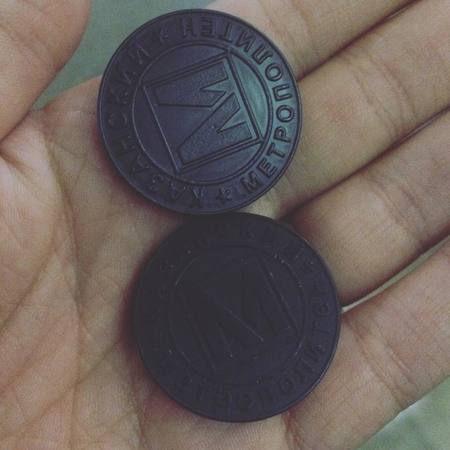The Metro in Kazan is a public transport system that runs underground through the city of Kazan, in the Russian Federation. Currently, it only has one line that connects 10 stations. This metro is the most recent system in Russia; it was inaugurated in 2005. However, the first projects and attempts of construction date back quite a while, to the 1930’s.
Despite being relatively new, the metro in Kazan has already undergone expansions, has renovated some its rolling stock, and has modernized and renovated several stations with the help of artists. The basic price is set at 25 rubles ($0.43 USD). The metro runs from 6:00 a.m. to midnight.
Metros in Russia: Kazan
Kazan is the capital of the Republic of Tatarstan, in the Russian Federation. It is also its most populous city, and the 8th largest in the country. The river Kazanka runs through the city and divides it into two areas. It then joins the Volga (one of the most important rivers in Europe), as it runs just south of the city. Kazan has about 1.15 million people living within the city limits, but there are about 1.65 million people in its metropolitan area.
While there is no consensus as to when the city was established, it was probably founded by the Bulgars of the Volga at the start of the 11th century. It is now known as Russia’s third capital (after Moscow and St. Petersburg). Kazan is a multiethnic city, and has a large Christian and Muslim population. While Russian is the main language, the Tatars (about half of the total population) use their own language among themselves. They are both official in the area. The city is home to the Kazan Kremlin Historical Complex, which was declared as a World Heritage Site by the UNESCO in 2000.
Kazan is also an economic powerhouse, as it is one of the largest financial and industrial centers in Russia. Many large Russian banks and corporations (mainly in the chemical and petrochemical sectors) have their headquarters here. The average temperature in summer is at around 19 or 20 °C, while the average in winter can be below -10 °C.
The Metro of Kazan is one of the newest in the country, as it was inaugurated in 2005. The total system length is 15.8 km. Because of its relative youth, the rolling stock is mostly comprised of the original trains (model 81-553/554), but newer models were later introduced (models 81-740/741). They were built by the Russian corporation Vaganmash, in partnership with Škoda Dopravní Technika, of the Czech Republic. About 47 wagons are currently operational. The annual ridership (of 2013) was estimated in 31.3 million, which is equivalent to about 86,000 people every day. The Metro belongs to the local government and is operated by it via the MetroElektroTrans company.
- Known as: Kazansky metropolitan
- System length: 15.82 km
- Track gauge: 1524 mm
- Number of lines: 1
- Number of stations: 10
- Website: www.kazanmetro.ru
- Operated by: MetroElektroTrans
- Daily ridership: about 86,000 people
- Inaugurated: August 27th, 2005
Brief history
The Kazan metro is the most recent addition to the metro systems of the Russian Federation, but the original plans and development projects go quite a while back. It is important to mention that this is the first system to be inaugurated after the fall of the Soviet Union, and while it still has many architectural elements of the metros of that time (like independent architectural themes on every station), it is very modern.
The original idea for the construction of a metro in Kazan dates back to the Russian Empire, but plans were scrapped when the revolution began. After things settled down, the project was again considered, but the Soviet Union had put a prerequisite: any city that aspired to have a metro system had to have at least 1 million inhabitants. Kazan reached this number in 1979, and in 1980, preparations were underway. The first technical studies were carried out, and the masterplan was in its initial phase, but the project was once again stopped in the late 1980’s due to economic problems and the eventual separation of the Soviet Union.
After the dissolution, Russia could not afford the project right away, and it was put on hold until 1997, when the government yielded to social pressure and authorized the construction. The original plan was heavily modified, both in the masterplan and layout of the line and in the design of the stations themselves. Finally, in August of 2005, the first phase of the metro was inaugurated by the federal and local authorities. Three minor extensions were later opened to the public in 2008, 2010 and 2013.
Line and stations
Currently, the metro system in Kazan has only one line. Since its original inauguration, the line has been expanded in both ends, and has reached a total of 10 stations distributed along a 15.8 km route. This first line has already assigned to it a color: red. Subsequent lines will have their own identifying color.
The current terminal stations of the system are Aviastroitelnaya in the north and Prospekt Pobedy in the south. All ten stations have different characteristics, making the first line of the Metro a peculiar one.
The first station (north to south) is Aviastroitelnaya, which is one of the newest additions to the system, as it was opened in May of 2013. It is underground and comprised of a single vault, reminiscing of an airplane aisle. After that, the trains reach Severny Vokzal and Yashlek stations, also opened in 2013.
 Ploshchad Tukaya (Kazan Metro)
Ploshchad Tukaya (Kazan Metro)
Both are underground. The first one is built with two vaults and a central row of columns with marble and glass ceilings that allow for natural light, while the second station has a single, large vault without columns, and a softer lighting with a classic decoration style that was maintained from the original project. This station connects with the main market and a commercial district.
The next stop on the line is Kozya Sloboda, an underground station inaugurated in 2010. It has a much modern design, with two rows of central columns that make extensive use of steel and other decorative metals. It is mainly used by students and staff of the Kazan State Power Engineering University. Continuing the ride to the south, the metro must cross the Kazanka river before reaching the next station: Kremlyovskaya. This station serves one of the biggest tourist attractions in the city: the Kremlin of Kazan. The metro station is part of the first phase, inaugurated in 2005. It consists of a single sub-surface vault with thematic decoration in the walls. The central area has 5 hollow towers (inspired by the towers of the Kremlin) that complement the walls and illuminate the platform. The ceiling is also beautifully decorated with colorful glasswork.
Next on the line is Ploshchad Tukaya station, an underground bi-span construction, supported at the center by what could be the most elegant concrete columns in the entire system, as they are beautifully encased in dark green and white marble. The columns are also covered by white marble, and contain mosaics between each span. This station is in the center of the city, near the Kuybyshev reservoir. Further along south, the trains reach Sukonnaya Sloboda station, a more typical underground station with two spans and a double row of columns supporting the central area. The colors used are lighter, and the general design is inspired in the historic cotton market above it. It is also located in the center of the city and connects to the College of Engineers.
The next station is called Ametyevo, the only station in the system that is not underground. The station is located right above an important street that runs along a valley that divides Kazan’s southeastern side. It has a modern high-tech design with three spans supported by thin pillars, and a blue glass encasing the entire station. The next stop is Gorki station, the last station of the initial phase. It has a two-tone high-tech design that mimics the industrial design used on the Soviet buildings in the area. This is one of the least concurred stations in the system.
The current southern terminal of the Kazan Metro system is the Prospekt Pobedy station at the Victory avenue. This station was constructed during phase two, and was inaugurated in 2008. It has a standard three-span construction, supported at its center by two rows of columns. The main theme of the station has the Soviet colors all around, at it is intended as a homage to the victory in the Great Patriotic War (the Eastern Front of World War II). The station is located in the intersection of Richard Sorge street and Victory avenue. Another station is currently underway to the south: Dubravnaya station. When completed (it is expected to be completed in late 2017), this will be the newest addition to the system and will become the new southern terminal.

Connections with other systems
As with all larger cities, there are many public transport systems in Kazan, all working together in benefit of its population. While the city centre is relatively small and most of it can be easily reached by foot, the city extends to the north and south enough that the metro cannot cover all of it yet. Other superficial transport systems bridge that gap and provide service to more remote or disconnected places in Kazan.
The city has three main public transport systems working alongside the metro: buses, trolleybuses and trams. There are 5 lines in the tram network, with a total of 131 wagons. Normal single-ticket costs 25 rubles ($0.43 USD), but there is a small discount for intelligent cards (23 rubles or about $0.39 USD). This network connects to the metro in 5 places: Aviastroitelnaya, Severny Vokzal, Yashlek, Gorki and Prospekt Pobedy stations.
The trolleybuses operate via a similar scheme, albeit with more flexibility and broader reach. They connect with the metro in almost all stations, except for Sukonnaya Sloboda and Ametyevo. There are 216 trolleybuses in the network. On the other hand, the buses have many lines, and all metro stations have at least one bus line connecting to it.
Medium and long-distance travel is also possible, as Kazan is connected to the Russian rail network. The trains arrive at the Kazan-Passazhirskaya railway station, an iconic architectural piece from the 19th century. To access the railway station from the metro, passengers must only reach Kremlyovskaya station. From here, users may board long-distance trains and up to 13 regional trains, as well as suburban railway networks. The trains are operated by Russian Railways. Connection to urban transport systems is also possible, as the station is served by buses, trolleybuses and tram lines.
The city of Kazan has another important transport network: the Volga river. From the city port, many nearby cities are reachable in a couple hours, but it is not limited to that. Any other destination near the Volga is reachable. For example, Moscow can be reached through the river, although it takes about 10 days to get there.
Connections to the airport
The Kazan International Airport serves the city and the surrounding area; it is located about 26 km to the southeast of the city center. It is the largest airport in the Tatarstan region, and the 15th busiest airport in Russia. Because of the distance separating it from the city, the metro does not reach it directly. There are plans to connect it to the system in the future, however.
In order to reach the metro from the airport, passengers have two options. The first one is to take a bus. There is a bus line that runs from 6:00 a.m. to 10:00 p.m. Passengers seeking direct connection with the metro can head to the southern terminal (Prospekt Pobedy), a ride that costs from 20 to 40 rubles ($0.34 to $0.68 USD).
The second option is the preferred among the airport’s users, as it is simpler and more convenient than the bus. It is an electric shuttle train connecting the airport to the Kazan-Passazhirskaya railway station. It has a cost of 22 rubles ($0.38 USD), and takes about 28 minutes to get from the airport to the station or vice versa. It has 5 intermediate stops.
Schedule and timetables
As the Kazan metro is still quite small, and only has one line, schedules and timetables are quite simple. The system is open from 6:00 a.m. until midnight. The total run time is about 22 minutes from terminal to terminal. Since the inclusion of the Russich 81-740/741 trains a couple years ago, the trains have a frequency of about 5 or 6 minutes during peak hours. When demand is low, trains may run at higher intervals.
 Kazan
Kazan
Tariffs, tickets and cards
The metro has a single fare, regardless of the distance travelled. The basic cost is 25 rubles ($0.43 USD) for any trip, but prices are slightly lower for travel cards. Tokens are used to grant entry to the system for a single trip. They are round with an aqua or dark green tone, and are acquired at the stations. There has been some criticism regarding this system, as it may appear antiquated. However, the tokens have a chip imbedded in them that controls their validity and allows the machines to read them. Detractors of the system have also pointed out that the same effect could be achieved by other more modern means without the need to carry the tokens around.
The metro has two distinct travel cards. The first one is rechargeable. After the initial purchase, a 45-ruble ($0.77 USD) deposit must be made, and the card then may be recharged with up to three months’ worth of travel. For this card, prices are significantly lower, at 15 rubles ($0.26 USD) per trip. After the three months are over, the card may be recharged for another three months. The second option is the city public transport card, that allows for trips in any of the city’s transport systems. The tickets vary in price, and the card can be used to buy unlimited tickets for the metro, trolleybuses, trams or urban buses. 50-ticket packs are also available. The cost per trip is of 23 rubles ($0.39 USD).
A new option has been recently implemented: contactless card payments. Passengers using this function must only hold their card above the tourniquet and the payment will be processed, charging the price directly to the user’s bank account or credit card. The price of the ticket is the same as the basic tariff: 25 rubles.
Rules and regulations
The Kazan Metro has a set of established rules and regulations intended to maintain order, make processes more agile, sanction irregular or dangerous behavior that may put the collective or other individual’s well-being at risk, and maintain the infrastructure’s integrity. Some of them are:
- Weapons are strictly forbidden inside the system. Users are not allowed to carry them, and there are specialized X-ray stations that scan passengers and luggage.
- Users who fail to comply with established security limits will be sanctioned.
- Pets, carriages and small bicycles are allowed.
- Free access to the system is granted to children under 7 years of age, people with disabilities and any other passenger with valid authorization. This benefit can only be used with a proper identification card.
- The elderly, children and people with disabilities have priority over the seats, so normal users should always yield their seat and contribute to making the system a positive experience for everyone.
Future expansions
There are many considered expansions for the metro in Kazan. Dubravnaya station is under construction and is expected to be completed shortly, extending the current line to the south. The masterplan for the expansion of the metro covers more than the extension of the existing line, however. Three more lines are already under development.
The first of these is the Savinovskaya line, identified by the color blue. It was originally intended to be up and running for the FIFA World Cup in 2018, but economic problems restrained that from happening. This line will be constructed in the near future, and will cross the city from east to west, connecting with the red line in Yashlek. It will connect residential and commercial areas, as well as important sporting venues such as the Kazan Arena.
 Kasan
Kasan
The other two future lines are the Privolzhskaya and Zanoksinskaya lines. The first one will probably be identified with yellow or purple, and will provide service in the south of the city, including a possible connection to the airport. The second one will be identified by the color green, and will run across residential zones, uniting areas around Gorki Park with the center of the city and the other lines, possibly expanding to the north of the city, where there are many residential zones.
Advice
- It is important to keep the token or valid travel card before entering the system, as they are required by the tourniquets.
- Russian metro stations have all different design and characteristics, so it is important to know how to identify the entrances and exits.
- Police elements are patrolling in each station. Go to them if you have any kind of problem.
Fun facts
- The use of cameras was banned until 2011. Professional photography is still banned.
- Severny Vokzal and Kremlyovskaya stations are the only metro stations in Russia that have access to natural light.
- The metro of Kazan was the first subway in Russia to include English in signs and announcements, apart from native Russian and Tatar.
- There have only been two incidents regarding the metro: two suicides. They both occurred at Sukonnaya Sloboda station.
- The system has different logos for the entrances and for the tunnels.
Tourism and sightseeing
Kazan has become an important cultural, technological and political center, not only in Russia but in the world, as demonstrated in recent years. Kazan has hosted multiple sporting events such as the World Fencing Championships, the World Aquatics Championships and the 2017 FIFA Confederations Cup. The Kazan Arena will also be a host in the upcoming 2018 FIFA World Cup. The city’s architectural and historical sites (the Kremlin being a great example of this), as well as its multicultural society and lively background have positioned Kazan as one of the most visited tourist destinations in Russia. Some of the most remarkable sites that are easily reached via the metro are:
The Bulak channel: originally developed as an important navigable waterway right in the middle of the city, it was the center for the fishing industry in the city. It is now a closed waterway that remains as a tourist attraction. It can be reached after a short walk from Kremlyovskaya station.
St. Nicholas Cathedral: it is one of main churches in the city, and the seat of the eparchy of Kazan and Tatarstan. It holds many important religious symbols, art and figures, such as the Virgin of Kazan. It is also reachable via the Kremlyovskaya station.
The Kremlin of Kazan: this citadel has a high architectural and historical value, and was declared as a World Heritage Site by the UNESCO in 2000. Within its walls lay very important buildings such as the Annunciation Cathedral and the Söyembikä Tower, the most familiar landmark in the city. It is very close to Kremlyovskaya station.
Karzansky Arbat: it is one of the most important pedestrian streets in Kazan. It has many shops and recreation areas, such as cafés and restaurants. It also hosts many cultural spaces. This street is located near Kremlyovskaya station.
Victory Memorial Park: located a couple blocks to the east of Yashlek station, this memorial park is dedicated to the victims of the war, and has an interesting expo on military equipment and vehicles used during the Great Patriotic War. Its ample green areas are ideal for outdoor recreation in late spring and summer.
Kazan metro map
- Passengers/Day 85000
- Fares:
- 24h operation: No
- Air Conditioning: No
- Walk between platforms: No
- Driverless trains: No
- Screen Doors Platforms: No
- Operator: MetroElektroTrans
- 7 roubles
- Kazan Metro Official Website
Help us
If you consider that the information we provide is wrong, not accurated, outdated, translation contains errors, and you would like to help us to improve the file...you can contact us here.
Feel free to contact us if you dont find the system you're looking for and we'll add it as soon as we can!
Thank you very much!








